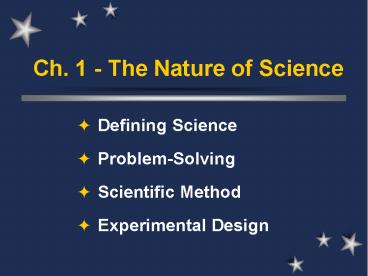Ch. 1 - The Nature of Science - PowerPoint PPT Presentation
Title:
Ch. 1 - The Nature of Science
Description:
Ch. 1 - The Nature of Science Defining Science Problem-Solving Scientific Method Experimental Design A. Defining Science Pure Science research that adds to the body ... – PowerPoint PPT presentation
Number of Views:184
Avg rating:3.0/5.0
Title: Ch. 1 - The Nature of Science
1
Ch. 1 - The Nature of Science
- Defining Science
- Problem-Solving
- Scientific Method
- Experimental Design
2
A. Defining Science
- Pure Science
- research that adds to the body of scientific
knowledge - has no practical use
- Applied Science (Technology)
- the practical application of scientific
knowledge
3
A. Defining Science
- PURE
- human genetics
- polymer science
- atomic theory
- study of the human ear
- APPLIED
- DNA fingerprinting
- Lycra spandex
- nuclear weapons
- hearing aids
4
A. Defining Science
- Life Science
- the study of living organisms
- Earth Science
- the study of Earth and space
- Physical Science
- the study of matter and energy
- chemistry physics
5
B. Problem-Solving
- 1. Identify the problem.
- What do you know?
- What do you need to know?
- 2. Plan a strategy.
- Look for patterns.
- Break the problem into smaller steps.
- Develop a model.
6
B. Problem-Solving
- 3. Execute your plan.
- 4. Evaluate your results.
- Did you solve the problem?
- Is your answer reasonable?
- Identify - Plan - Execute - Evaluate
7
C. Scientific Method
- Hypothesis - testable prediction
- Theory - explanation of why
- based on many observations experimental results
- Scientific Law - prediction of what
- describes a pattern in nature
8
C. Scientific Method
- Theories and laws are well-accepted by
scientists, but...
THEY ARE NOT SET IN STONE!
They are revised when new information is
discovered.
9
C. Scientific Method
- 1. Determine the problem.
- 2. Make a hypothesis.
- 3. Test your hypothesis.
- 4. Analyze the results.
- 5. Draw conclusions.
10
C. Scientific Method
- 1. Determine the problem.
- When the Titanic sank, what happened to the
water level on shore? - 2. Make a hypothesis.
- The water level rose.
- The water level dropped.
- The water level stayed the same.
11
C. Scientific Method
- 3. Test your hypothesis.
- How could we test our hypothesis?
- 4. Analyze the results.
- What happened during our test?
- 5. Draw conclusions.
- Was our hypothesis correct?
- Is further testing necessary?
12
D. Experimental Design
- Experiment - organized procedure for testing a
hypothesis - Key Components
- Control - standard for comparison
- Single variable - keep other factors constant
- Repeated trials - for reliability
13
D. Experimental Design
- Types of Variables
- Independent Variable
- adjusted by the experimenter
- what you vary
- Dependent Variable
- changes in response to the indep. variable
- what you measure
14
D. Experimental Design
- Hypothesis
- Storing popcorn in the freezer makes it pop
better. - Control
- Popcorn stored at room temp.
15
D. Experimental Design
- Single variable
- Storage temperature
- Constants
- Popcorn brand
- Freshness
- Storage time
- Popper
16
D. Experimental Design
- Independent Variable
- Storage temperature
- Dependent Variable
- Number of unpopped kernels

